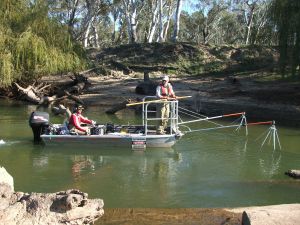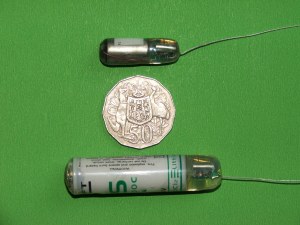Here’s a guest post from one of my newest PhD students, Jarod Lyon of the Arthur Rylah Institute in Victoria. He’s introducing some of his ongoing work and how he incorporates anglers into conservation research.
As most conservationists know, snags (fallen trees and branches in rivers) are the riverine equivalent of marine reefs, providing critical habitat for many plants and animals, from microscopic bacteria, fungi and algae through to large native fish. They are the places where the greatest numbers and diversity of organisms occur in lowland sections of rivers. Their presence has an important influence on the overall health of these rivers.

- Figure 1
Ins southern Australia, Murray cod, trout cod and golden perch are three iconic fish species that occur in the Murray River (Figure 1). Recent investigations into the ecology of these species have demonstrated a strong dependence on the presence of snags – a relationship well-known to recreational anglers who target both Murray cod and golden perch. Unfortunately, the abundance of these species has declined over the past 100 years and they are now considered threatened. Excessive removal of snags has been identified as a primary cause for this decline. For example, in the Lake Hume to Lake Mulwala reach of the Murray River, over 25000 snags were removed in the 1970s and 1980s to improve the passage of water between Lake Hume and the large irrigation channels at Yarrawonga.

- Figure 2
The largest resnagging project ever undertaken in Australia is now in full swing. It aims to reverse the legacy of clearing snags that has occurred along the Murray reaches since European settlement. The resnagging is occurring in the Hume-Mulwala reach of the Murray using trees that were cleared for the Hume Highway extension between Albury and Tarcutta, and will create substantially more physical habitat for native fish in this reach of the river. By creating this habitat, the size of the native fish population in this reach is expected to increase thereby improving the conservation status of the native species present, and improving the quality of the recreational fishery for native species (particularly Murray cod and golden perch). It is the largest project of its kind ever undertaken in Australia, and is a great step towards recovering fish populations. The project is funded under the Murray Darling Basin Commission‘s Living Murray Program, and is being undertaken by a variety of state and national organisations, in particular NSW Department of Primary Industries and Victorian Department of Sustainability and Environment (DSE).
To ensure that the resnagging is having a beneficial effect on the numbers of native fish in the reach, a comprehensive monitoring and evaluation program is being implemented by scientists from the DSE’s Arthur Rylah Institute. This program is determining whether an increase in the size of the native fish populations is the result of:
- Increased recruitment in the reach
- Increased survival of adults in the reach
- Increased immigration of adults and juveniles form Lake Mulwala and the Ovens River
- Decreased emigration form the reach
To measure these changes, the fish populations between Hume Dam and Lake Mulwala are being surveyed once a year to determine the population size and level of recruitment. For the purpose of comparison, surveying between Yarrawonga and Tocumwal, in the lower Ovens River, and in Lake Mulwala, is also being undertaken.

- Figure 3
Some of the fish caught (Figure 2) will be tagged with an external tag, internal tag or radio transmitter (Figures 3 & 4). All tags have a unique number that identifies the individual. The recapture of these individuals, both by researchers and by anglers, allows survival and movement patterns to be measured.
The external tags are plastic polymer tags and are easily visible, protruding from the dorsal fin area. These tags are used to allow information from anglers to be directly used in the monitoring. A phone number is printed on each tag and when anglers call this number to report that they have caught a tagged fish, this provides valuable information on the not only fish survival and growth, but also the performance of the recreational fishery. These tags have a lifespan of 2-5 years. Anglers who call in tag information are also eligible for a reward (usually a stubby holder or lure) and get sent a certificate which gives details of the history of the fish which they have captured and reported.
The internal tags are implanted into the area to the front of the pectoral fin, are not visible, and unlike the external tags, are permanent. The tags are passive integrated transponder (PIT) tags (Figure 4), similar to those used in the pet and livestock industry. The tags are important as they allow a long-term record of fish survival, growth and movement to be measured. Fishways across the Murray Darling Basin are increasingly being installed with readers that can detect these tags. This can give researchers valuable information on long-range movements. For example, one fish (a 20-kg Murray cod) that was tagged in the Murray river near Corowa, was picked up on a PIT tag reader at the bottom of the Torrumbarry Weir fishway – a fair feat when you consider that this fish has had to get through both Mulwala and Torrumbarry Weirs, as well as travel a distance of over 200 river km downstream!

- Figure 4
Radio transmitters are surgically inserted into the body cavity of the fish (Figure 3). These tags emit a radio signal that can be tracked continuously (Figure 5), and allow a rapid assessment of the movements (i.e., emigration and immigration rates) of a population to be determined. The tags are also detected by an array of 18 logging stations located along the river between Lake Hume and Barmah (Figure 1). Approximately 1000 radio tags will be implanted over the life of the project – making it possibly the largest radio-tagging program in the country.
If you catch a tagged fish, please record the type of fish, its number, its length (and its weight if possible) and the location of its capture and report this information on the phone number printed on the tag. These angler records improve the quality of the data collected and reporting of angler captures is encouraged through the rewards program.
As well as the general tag return program, a more targeted “Research Angler Program” is being undertaken. The angler program commenced operations in July 2007. The project was developed to assist with the scientific monitoring and communication requirements of the native fish habitat restoration project.
This section of the monitoring recognises that local anglers can contribute information about the state of native fish in the River Murray by recording their fishing effort and the amount of fish captured. Such information, in addition to greatly increasing the community awareness of the monitoring program, also adds another ‘string to the monitoring bow’ in that it will form a long-term dataset of fish captures, which can eventually be linked to the resnagging effort. The information gathered will be entered into a database and analysed to help assess changes in fish population size in relation to the habitat rehabilitation project.

Figure 5
Instream woody habitat is a vital component to the lifecycle of Murray Cod and the endangered trout cod. The resnagging of the River Murray – Hume Dam to Yarrawonga, will conserve and enhance native fish communities. Continual monitoring and interactions with the local angling fraternity is a crucial part of the success of this project.
The anglers have logbooks and have been trained in removing the otoliths, which are the earbones, from fish that they are taking for the table. We can then use the otoliths to determine the age and growth of the fish in response to the resnagging work.
Since December 2007 the fishers with the resnagging Angler Monitoring Program have captured over 65 Murray Cod, with over 95% of these fish released. Anglers have caught and released other native species such as golden perch and the endangered trout cod.















 I’m not sure if many South Australians are aware of this, but the Parliamentary Inquiry into Biodiversity by the
I’m not sure if many South Australians are aware of this, but the Parliamentary Inquiry into Biodiversity by the 































